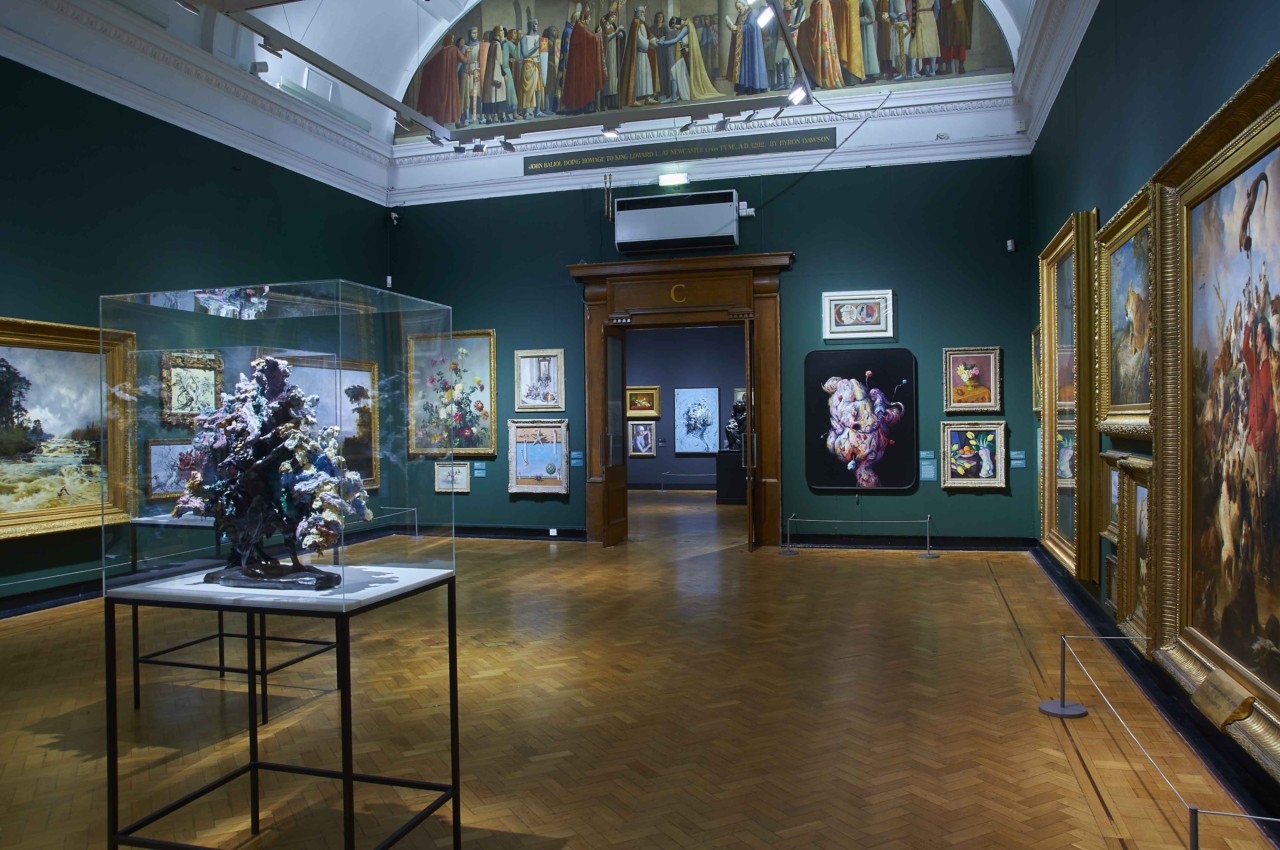


Installation view of 'Glenn Brown: Fantasy Landscapes, Portraits and Beasts' at the Laing Art Gallery. Photographer: Jack Cornish.
So rich in images and ideas is this new show at the Laing in Newcastle that it is hard to know where to jump in. Glenn Brown was given total freedom of the Laing Art Gallery collections, and the result is a glorious riot of works that spins across periods, genres and subjects, with an artist’s eye and curiosity. There are multiple paths to follow, stories to unpack, with Brown’s own paintings and sculptures acting as signposts along the way.
There are two entrances to the show and no right or wrong way to approach it, although by the entrance from the grand staircase the first work you encounter is a perfect opener: William Orpen’s 1902 Self Portrait as Chardin has the artist adopting a different persona before the canvas. Swathed in capacious painting smock, his piercing eyes turned questioningly to the viewer, Orpen is in deep communion with his forbears. Then you turn to your right and take in Pier Francesco’s strange and disquieting Blind Beggar from 1650 – mouth gaping wide, unseeing eyes closed, and you are instantly plunged into the universe of dualities and reversals that Brown has conjured.
Over on the other side of the gallery is one of the Laing’s treasures: Isabella and the pot of basil, 1868, by Holman Hunt. In it a young woman leans her head against the pot of basil of the title, her luxuriant dark hair flowing over the pot, her arms circling it. Oriental rugs, marble floors, drapery and inlays heighten the sensuality. In the background you glimpse a tumbled, unmade bed. Taking its theme from John Keats’ poem, the pot of basil contains the head of Isabella’s lover, Lorenzo, who was murdered by her brothers. Beauty and decay haunt this show.
In the second space, on either side of the connecting doors are a large flower study by Jean Benner from the late 19th century and Brown’s International Velvet, 2004. Seemingly radically unrelated, the paintings speak to each other across the wall, through scale, composition and palette. Brown’s painting appropriates a painting of a soldier by Georg Baselitz, flips it upside down, removes the legs and buries the arms in a flurry of brushstrokes. Bizarre orifices emerge from the now deliquescent fleshy mass, some with flowers sprouting from them – the arc of their stems echoing the dahlias in Benner’s work on the other side of the doors. More than memento mori, the juxtaposition of the erotic grotesque and the mundanely beautiful is almost Sadean.
Also in this gallery Brown has rescued two great Landseer ‘machines’ from their safe, pastoral ‘Englishness’. The portrait of cattle showcases the painter’s great mastery in depicting animals. The extraordinary The Otter Speared, 1844, has languished in storage for many a year, for fear of the wrath of animal rights activists. A pyramidal composition of baying hounds, the otter of the title is held aloft, a slick curlicue of writhing beast, still fierce in its death throes. So emotive is this image, one could suspect Landseer of being an activist himself. Alongside these two works is Brown’s Anaesthesia, 2001 – his reworking of Landseer’s saccharine Dignity and Impotence, 1939, bathed in bilious green light. The second, smaller dog has become creepily skull-like in Brown’s rendering.
It is great to have a chance to see The Aesthetic Poor (for Tim Buckley) after John Martin, 2002, on loan from the Zabludowicz Collection. This is one of the works for which Brown made his name – appropriating the work of a slightly neglected English painter and giving his apocalyptic visions a sci-fi spin. He has flanked it with an original Martin painting, and minor work by his studio, stylistically similar but a million miles away in execution. Copies vs originals, back and forth across history, not always the way we expect.
Brown’s smaller landscape painting after sci-fi painter/illustrator Chris Foss, Everyone Sang, 1996, has the sun setting in an alien world, weird architecture dominating the foreground. Set against the spikey abstraction of Graham Sutherland’s landscape, it sharpens the sense of strangeness of that artist’s vision, as well as connecting to John Martin’s fantasy visions elsewhere in the gallery.
While I was in the gallery, people were gathered in clusters discussing the works – utterly engrossed. Glenn Brown has produced a show that gives an exhilarating sense of the doors of the museum’s stores being thrown wide open to reveal their treasures, and doing it in such a way as to offer a deeper understanding of the roots of his own work. As well as his sense of humour. Which is enjoyably dark.
Should you be lucky enough to be in Newcastle while this show is up, prepare to devote some serious time to visiting. You are in for a treat.
Caroline Douglas
Director
Laing Art Gallery, New Bridge Street, Newcastle upon Tyne NE1 8AG. Open Tuesday - Saturday, 10am - 5pm, Sundays 2pm - 5pm. Exhibition continues until 21 October 2018. www.laingartgallery.org.uk